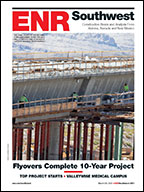When the Senate Judiciary Committee opens confirmation hearings Sept. 6 to consider John G. Roberts to be the Supreme Courts 109th justice, lawmakers will be questioning a jurist familiar with construction cases and a range of business and environmental issues.
Roberts, nominated July 19 by President Bush to succeed retiring Justice Sandra Day OConnor, weighed in on cases affecting business interests during his brief tenure as an appellate court judge. "He is highly regarded and well respected by the legal and business communities," says Thomas Donohue, president of the U.S. Chamber of Commerce. But environmentalists have concerns about his views.
His reputation among corporate officials steered the Associated General Contractors to Roberts in the mid-1990s, when, after a stint as the Justice Dept.s principal deputy solicitor general, he was a partner in the Washington, D.C., law firm Hogan & Hartson. Roberts wrote three amicus curiae briefs for AGC, the first for the controversial Adarand Constructors Inc. affirmative action case,which focused on contract set-asides. The court deemed set-asides improper, which led to a tightening of affirmative action programs, a view supported in the AGC brief.
For the trade groups brief in Adarand to have an impact on the outcome of the case, AGC General Counsel Mike Kennedy says, "Any arguments would have to be intellectually honest and principled. We were looking for an attorney with the highest levels of intellectual integrity." Roberts was recommended by several people, notes Kennedy, who says he has worked off and on with the nominee for about 10 years.
In a 1996 case, Brown v. Pro Football Inc., Roberts expressed AGCs views that an anti-trust exemption for contractors engaged in multi-employer collective bargaining agreements should stand. Although that case was brought by a National Football League player, it had the potential to disrupt collective bargaining in the construction industry, Kennedy maintains.
The Sierra Club is concerned about Roberts views on the Commerce Clause, which has allowed Congress to enact laws such as the Clean Air, Clean Water and Safe Drinking Water acts.
Despite tough questions Roberts will face from Republicans and Democrats, his confirmation is expected to go smoothly and be finished by the Oct. 3 start of the Supreme Court session.
| Wehrum was named principal deputy administrator on July 25, soon after Holmstead announced his resignation. Wehrum was Holmsteads counsel for nearly four years and before joining EPA was a attorney in Holmsteads former law firm, Latham & Watkins. If the White House nominates Wehrum, environmentalists predict a confirmation battle. He is seen as pro-industry and the point man in rolling back clean air rules, a source says. While Wehrum is not viewed as a shoo-in, no other names have surfaced. In a report released Aug. 26, GAO faults EPA in several areas, saying the agency has failed to issue a strategy for mercury permitting that it had committed to produce. GAO also says EPA has not settled a long dispute with Wisconsin on adopting the initiatives provisions. Grumbles says area states mercury criteria have had "a high level of consistency." He says EPA feels a permitting strategy would not improve that consistency. OSHA: New Deadline Set for Standard on Construction Lead |



Post a comment to this article
Report Abusive Comment